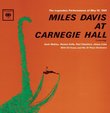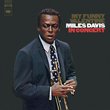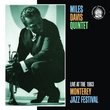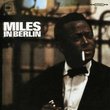| All Artists: Miles Davis Title: Miles in Europe Members Wishing: 0 Total Copies: 0 Label: Sbme Special Mkts. Release Date: 4/29/2008 Genres: Jazz, Pop Style: Bebop Number of Discs: 1 SwapaCD Credits: 1 UPC: 886972670225 |
Search - Miles Davis :: Miles in Europe
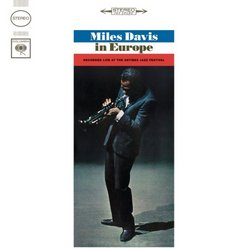 | Miles Davis Miles in Europe Genres: Jazz, Pop
|
Larger Image |
CD DetailsSimilar CDs
|
CD ReviewsQuality Transitional Miles Recording A. Douglas Robinson Jr. | Gastonia, North Carolina United States | 07/06/2006 (5 out of 5 stars) "This was a transitional band for Miles Davis. From the final breakup of his band with John Coltrane and/or Cannonball Adderly fronting a rhythm section of Wynton Kelly/Paul Chambers/Jimmy Cobb, until the formation of the famous "2nd Classic Quintet" with Wayne Shorter/Herbie Hancock/Ron Carter/Tony Williams, Miles band went through changes in both personnel and artistic temperament. The rhythm section changed from Kelly/Chambers/Cobb to Hancock/Carter/Williams and the front line experienced even more radical turnover. After Trane left Miles to begin his solo career, Miles went through a string of saxophonists looking for that elusive quality of exploration/combustibility/agressiveness that Trane brought to the sound of Miles' group. After Trane, Sonny Stitt, Hank Mobley, Frank Strozier, George Coleman, and Sam Rivers all spent some time in the saxophone chair before the band finally gelled with the addition of Wayne Shorter in the fall of 1964 (represented in another new live cd release "Miles: In Berlin"). The signficant thing about this live performance from France in 1963 is that it is the first recorded performance of the band with Tony Williams on the drums. With the addition of Williams, the rhythm section of the 2nd classic quintet (Herbie Hancock/Ron Carter/Tony Williams) became firmly entrenched and the future artistic trajectory of the group was set. What is most interesting about this performance to me is hearing the tension between Miles' musical past and future playing out in the sound of this group. George Coleman on tenor saxophone represents the hard bop/mainstream approach that had dominated Miles sound since the formation of the "first classic quintet" in the mid 1950s. In my opinion, Coleman's performance here and in the February 1964 concert (My Funny Valentine/Four and More) represent some of the best recorded solos of his career. Taken together they beg for a reassesment of Coleman as a much greater player than he has traditionally been given credit for. Hopefully the release of this recording on cd in the U.S. will help in that regard. Coleman was incredibly confident at this point and plays with absolute authority and complete control over his instrument. Moreover, he doesn't seem the least bit intimidated by the more adventerous young rhythm section he was playing in front of. If anything, based on the aural evidence, he actually was greatly inspired by the challenge they presented. The seeds of Miles future development were planted with the opening chords played by the Hancock/Carter/Williams rhythm section. One of the things that made this rhythm section so special was its incredibly elastic sense of time/rhythm. Even at this early date, you can already sense the extent to witch Hancock, Carter, and particularly Williams are chomping at the bit to stretch the confines of traditonal "swing" rhythms to the breaking point. At the same time, they remain absolutely tight and cohesive. In addition, Herbie Hancock already shows a willingness to take the harmonic sopistication and impressionistic/absract sound of Bill Evans a step further. Granted, on this album, the rhythm section is still playing relatively conservatively. Nonetheless, you can catch unmistakable glimpses of their youthful exuberance and sense of adventure as they almost imperceptibly push the music ever so slightly "out" only to have it edged back in again by Miles/Coleman. Listen closely and all these undercurrents are there in this band in this concert: Miles and Coleman at the top of their respective games and reeling off inspired solo after inspired solo while also somewhat reining in the radical tendencies of the rhythm section. Meanwhile, the rhythm section provides unflagging support to Davis and Coleman while also subtly subverting and pushing against them at the same time. Fascinating stuff....... Miles Davis was obviously a genius and one of the seminal figures of not only jazz music but of 20th century American music. However he was never considered a particularly gifted technical trumpeter compared to more virtuoso players like Clifford Brown, Lee Morgan, or Freddie Hubbard. What Miles is known for is the strength of the musical ideas he expresses through his horn and his uncanny use of space/silence to accentuate the effectiveness of the notes he actually plays. In spite of this general reputation for a lack of technical rigor, I find Miles' playing from this period with this band to be some of the most technically commanding and rigorous of his career. Listen to his solo in this album on "I Though About You" or his solo on "My Funny Valentine" from the February '64 concert and you would question the discernment of anyone who had the audacity to impugn Miles' chops on the trumpet. Located somewhat awkwardly in time and style between the peaks of Miles more famous bands and recordings, this live recording nonetheless contains endless pleasures for those willing to delve into its intricacies. Whether you are a Miles fanatic or a relative newcomer, you will find it greatly rewards repeated listenings." Essential music jsa | San Diego, CA United States | 04/05/2006 (5 out of 5 stars) "I bought "Miles Davis in Europe" on vinyl over 30 years ago & never got tired of listening to it - a great band recording great music just before Miles went off into his abstract period. One of the distinctive apects of this classic disc is the piano playing of Herbie Hancock. His geometric solos & ornamentations are endlessly interesting, perfectly complementing the ethereal playing of Miles Davis & George Coleman. Despite all of the kudos for the fine "Friday & Saturday Night at the Blackhawk" sessions, I think "In Europe" is much more interesting. One side note - the cd cover reproduces the original album art, which mistakenly identifies the recording as stereo. The sound, which is excellent, is actually mono." A new band, just getting warmed up Michael St John | St. Paul, MN | 02/14/2007 (3 out of 5 stars) "Recorded in July 1963, just two months after Miles had put this band together. The group had recorded its half of Seven Steps to Heaven in May, played a series of engagements in St. Louis, Chicago, and Cleveland from late May through June 23, then hit the stage in France to record for posterity a month later.
Of course the band hardly had a chance to form its own identity. George Coleman sounds heavily under the influence of John Coltrane, and the new rhythm section of Hancock-Carter-Williams, which would later turn the Miles book inside-out, here sounds not unlike the Kelly-Chambers-Cobb unit it had just replaced. Four of the five numbers on the album were familiar selections of the Miles book from '54-58 (and the bonus track on the latest CD issue originates from 1960); "Joshua" being the one tune new to the audience at the time. There is no deconstruction, no stretching and pulling at forms, like the musicians would start to do in 1964. The festival audience, familiar with the Blackhawk records or Miles' Fall 1960 European tour with Sonny Stitt, heard probably just what it expected. What makes it still worth hearing is the energy of the performance. Miles sounds invigorated, and most of the set is taken at a rapid clip, urged on by Tony Williams. It's almost like a Miles Davis & the Jazz Messengers kind of kick. Sometimes a record of frisky mainstream jazz is just what hits the spot, but this is one of the less essential live albums in Miles' career. There would be much more important and interesting records to come by Miles with this band, and the rhythm section in particular." |

 Track Listings (7) - Disc #1
Track Listings (7) - Disc #1